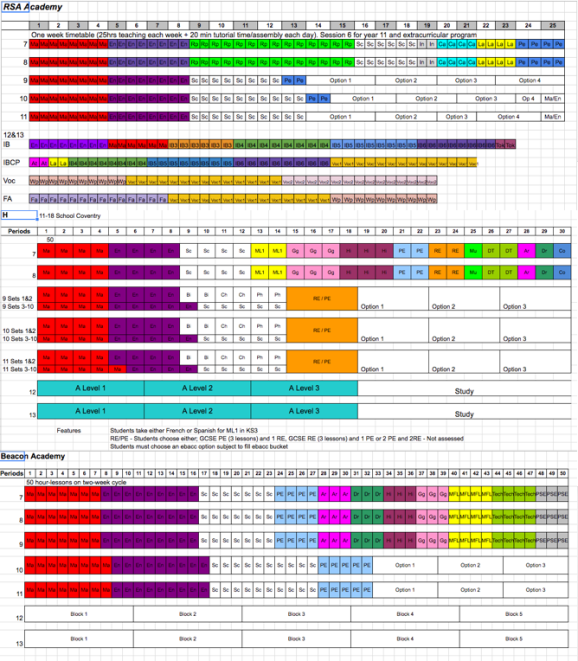
With enormous thanks to everyone who has contributed, the spreadsheet below now shows the curriculum models for 40 different schools. I’m going to stop there.
https://docs.google.com/spreadsheets/d/1fuZV6mg5BQLDnQ3xACDMqTuKbUKZGr5k9iYz56RpDvM/edit?usp=sharing
The collection includes the models for grammar schools, comprehensives, middle schools and international schools. No two are the same. There’s a mixture of 25, 30, 50 and 60 period cycles.
There are some definite trends:
A tendency towards having three option blocks – previously most schools would have had four. This reflects the need to teach each option subject in more time given the greater demands of each course.
There is a lot of time given to English, Maths and Science – although the exact amount of time varies quite a lot.
The three-year GCSE programme is also on the rise compared to my last collection in 2014.
More analysis to follow in due course. Thanks again to everyone who found the time to add their model. Hopefully this will serve as a resource for curriculum and timetable planners still wrestling with their model.
UPDATE November 2017: Analysis by Tim Mullen-Furness
I’m hugely grateful to Tim for undertaking the huge task of analysing the data in the 40 models. It’s complicated because there are so many variables. In the spreadsheet linked below you can see the averages and type in the number of the model to compare each one with the averages and medians. Amazing stuff!
https://docs.google.com/spreadsheets/d/10eeK15D7U3fI7N2w5BKX-SGC9IyeGcFBo0VefvPXDJE/edit?usp=sharing
Some headlines:
|
Summary of Averages
|
||
| % Overall | % at KS4. | |
| English | 9.62% | 15.86% |
| Maths | 9.36% | 15.62% |
| Science | 10.27% | 19.11% |
| MFL | 6.71% | 10.27% |

Will apply mine. Moving next year to a three year KS4 model so any advice from those who have made the shift would be appreciated!
LikeLike
Great. Look forward to seeing it. Thanks
LikeLike
David Didau was telling me the other night that Christine Counsell at the Inspiration Trust was going for a four year KS3 (I think). That might be an intersting outlier.
LikeLike
Pretty standard plan I think but loving the sharing by others, helps for future planning
https://docs.google.com/spreadsheets/d/1_yigAJ08nS_Zs1ErX5A7bpEPwTMglpEu13lj3PuHlgA/edit?usp=sharing
LikeLike
Thanks. I’ve added it to the master spreadsheet.
LikeLike
Your image really caught my attention. But after I read the blog I still wasn’t sure what I was looking at. Maybe since I am American I am used to something else? Out of curiosity, could you tell me how it works?
LikeLike
You need to look at the spreadsheet via the link. Each tab shows a model of the school curriculum – the number of lessons per week or fortnight given to each subject.
LikeLike
Having just moved to an international school in Spain and picked up timetabling, I thought I’d share mine. It’s interesting to see how the English ebacc hasn’t had an impact…
LikeLiked by 1 person
Reblogged this on The Echo Chamber.
LikeLike
Hi Tom. This is brilliant! You mention further analysis to follow…when might that be? Thanks
LikeLike
Maybe over the Easter holidays. A work in progress.
LikeLike
[…] I think there’s a tendency to focus a lot on the curriculum structure at a macro-level. This collection of 40 models shows how every school has a unique solution to the big puzzle of slicing up the learning time in a […]
LikeLiked by 1 person
St Richard’s Catholic College curriculum models 2016-2017 and 2017-2018.
https://drive.google.com/drive/folders/0BxsB4ZToMLAzVDBVQlJKei1tbXc?usp=sharing
LikeLike
[…] worked with on curriculum design. There are so many permutations and compromises. As my collection of 40 models shows, every school has a unique solution. There are so many competing pressures and […]
LikeLiked by 1 person
[…] 40 Curriculum Models 2017: […]
LikeLike
this is really interesting, thank-you (my curriculum is in there somewhere!) What i also find interesting is how these models are then timetabled – how subjects are blocked together. For example, i have a literacy block and a numeracy block in Y7&8: literacy being English, humanities, PCSHE etc; numeracy being Maths, Science, Computing plus a couple of others. Literacy by tutor group/ numeracy in maths sets. BUT, it was hard to timetable. I would be interested to know what others are doing.
Ian
LikeLiked by 1 person
[…] Last year I was interested in curriculum models and, with the help of twitter, I collected 40 models at the level of subject time allocations: 40 Curriculum Models 2017: […]
LikeLike
Just analysing and having a brain freeze… I can’t work out what GAM would be as this code appears a few times. Also La (when MLF has already been used), EML, and SI. Anyone got any ideas?
LikeLike
Games, Latin, European Modern Languages. Not sure about SI.
LikeLike
[…] is so essential, and perhaps hasn’t always been given the consideration it deserves. A call by Tom Sherrington in 2017 to share curriculum* models highlighted the wide variety of timetabling models out there: […]
LikeLike
[…] task is to get your hands on the curriculum models and materials from elsewhere. You can see my 40 models from 2017 for example – at the macro timetable level – but really I’m talking […]
LikeLike
[…] to timetabling in the new school year, I reflected on the work Tom Sherrington did a few years ago about secondary timetables. Unfortunately, the primary curriculum timetable is not so easy to analyse, given that very few […]
LikeLike
[…] 2017 I produced a collection of 40 secondary curriculum models: 40 Curriculum Models 2017: It contains a set of models from a range of school types including some middle schools. People […]
LikeLike
Do you know of anyone or any where there may be a template available for curriculum mapping exercises within and across departments
LikeLike